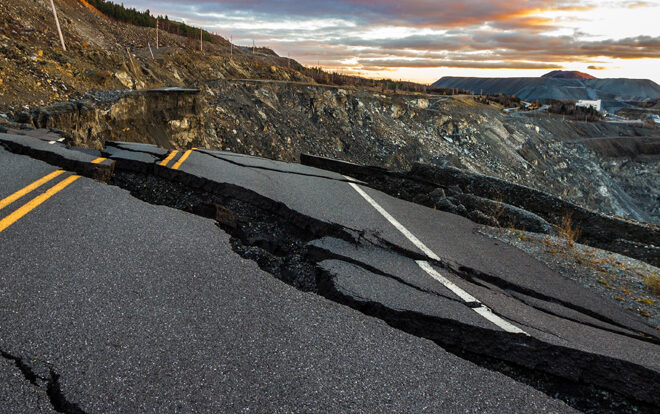Emergency responses
Jean-Pierre Blondin is Railway Manager at Norda Stelo. He has dedicated his career to transportation engineering infrastructures. We wanted to benefit from his 22 years of field experience to discuss a subject that is sensational, to say the least: emergency responses. Whether it’s a train derailment, a collapsed culvert or a highway blocked by an accident, Jean-Pierre has seen in it all. Emergency responses often receive heavy media coverage, but what happens behind the scenes?
Here is an informal discussion that plunges us into the reality of emergency response as part of consulting engineering mandates.
Camille Wilhelmy (CW): Hello Jean-Pierre, thank you for being here with us today and taking the time to share your experiences in the field, especially in emergency responses. Let’s get directly to the point: how do you approach an emergency?
Jean-Pierre Blondin (JPB): Really, rule number one is to produce an action plan. You mustn’t start running around like a chicken without a head. You have to prepare in advance. It’s difficult to intervene on an infrastructure, especially when you don’t know it. You must have studied the plans, know its structure and have read the inspection reports and load analyses. Otherwise, it’s very likely you’ll make the wrong call. You’ll assume certain things, and this increases the risks of making a wrong decision.
CW: When you say you prepare in advance, do you mean a response plan already exists in case of emergency, or that once in the emergency context, it’s essential to take time to think before acting?
JPB: In an ideal world, we’d do both, but in fact, it’s often a mixture of all that. It depends on the mandate, the client and our history with the infrastructure.
For example, I’m thinking of one of our clients in Montréal. They recently purchased a network of several structures and were obliged to put emergency procedures in place to know how to respond if anything happened on their bridges. In this case, the first thing we did after winning the call for tenders was to consult the plans and studies of the existing bridges.
These are railway bridges used by passenger trains. During rush hour, there’s one train after another. The cars are packed with people! Because of this, the response time must be less than 30 minutes. We absolutely must be prepared. When we’re called, we have to act quickly… And it happens! We’re called a few times a year.
In a case like this, even before our mandate begins, we’ve gone to see the bridges, we’ve looked at the inspection reports and we’ve consulted the bearing capacity studies. We learned a lot. We did our homework. Then we established a communications structure. We set up a 1-800 number that was given to different responders. We always have a bucket truck on standby and there’s always someone on duty evenings, nights and weekends – there’s always someone sober and available.
When an accident occurs, the communications chain starts working. The resource goes onto the bridge and looks at the damage. That’s when we start making decisions. Because there are trains up there with real people. They’re waiting. They call the babysitter and then their loved one, and they ask themselves: “When will I get home?” We understand them and we want to act quickly, but above all, we have to do everything right. We don’t take this lightly, but we can’t let a train cross a bridge and cause a disaster! We have to take time; we have to know the infrastructure methods.
We also receive emergency calls from clients when we don’t necessarily know their assets. In these cases, the first that responds to the call with a game plan that holds together is chosen. We have to respond quickly and dig into our knowledge; sometimes we know the type of bridge, the type of behaviour. That helps us respond.
Maybe three years ago a culvert of a structure collapsed on Autoroute 20. This was a disaster scenario: the 20 was closed on Friday afternoon at St-Hyacinthe. The client called different firms and contacted me because he knew me well. As soon as I hung up, I called some colleagues; I called Martin, I called Richard, we checked what could be done, who would we have available? Could we help?
And in fact, we had competent resources available. I called back right away and said: “It’s OK, my people are ready, I have someone who’s getting into his car right away.” I responded so fast that we obtained the contract. Finally, this response was converted into a monitoring mandate lasting several months! Emergency responses often are transformed into very gratifying challenges for Norda employees!
You see, in this case, this wasn’t an infrastructure that we knew, but it was a big culvert. And we know culverts! It was on Autoroute 20, very close to us, and above all, we had the necessary resources. Our team had the right mindset! That means they were able to respond in an emergency. Nobody said: “Oh well, we’re going to need a work program, we’ll need terms of reference, we’ll have to get authorizations, it’s going to take two weeks to implement…” That’s not the mentality at all in emergency response! It takes a firefighter’s mentality. And our teams are used to this: to reacting quickly and responding to emergencies with a cool head.
CW: You’re talking about a cool head, a firefighter’s mentality… Is there a quality you absolutely must have for an emergency response to succeed?
JPB: For this to work, it takes self-confidence and expertise. Even more important, it takes confidence in your team! That’s where the strength of a team comes from. You have to know each other, know each person’s strengths and be able to rely on your colleagues’ expertise. For example, you couldn’t pick an expert out of the Norda Stelo directory. For this to work, there has to be cohesion, a kind of well-established confidence in what your colleague will do. That’s essential!
CW: Is there a prioritization exercise to be done? There must be pressure from several fronts at the same time in the scenarios you describe. The client, the users, the environment, money and all the rest – how do you manage all of this?
JPB: Oh, that takes experience! It’s really experience that comes into play. Obviously, there’s one “no brainer” in setting priorities: human life. Human life and public safety are always the absolute priority, even to the detriment of other factors. For example, to secure a structure in an emergency, we won’t do environmental impact studies or public consultation. If there is a structure that can cause injuries or destroy lives, then human life is the top consideration. We nonetheless rely on our experience and good judgment to operate according to good practices, minimizing the environmental impacts and controlling the costs.
There are situations where human life isn’t directly in danger, but where the priority still is to restore the bridge to service as soon as possible. For example, I’m thinking of a response done by Dominique Bernard’s team this winter. Autoroute 299, which crosses the Gaspésie, was blocked completely. Ambulances and firefighters couldn’t get through. All the residents of the villages on the other side had to drive all around the Peninsula, a detour of nearly 10 hours, to get to their destination. In these cases, it’s indirect, but human safety is still at stake. So we do everything we can to put the bridge back in service as soon as possible.
In other cases, human life isn’t one of the issues. We enter another category of emergency response where the consequences often are economic. Contrary to highway bridges, it’s fairly easy to calculate the economic impact of a railway bridge. This is a fairly precise calculation with a result that often amounts to several hundred million dollars. Sometimes this can directly affect the survival of major companies dependent on their railways. If the bridge is unusable for several days, the company risks bankruptcy, and often the quality jobs of an entire region suffer from the aftereffects. In these cases, we must also act quickly and invest the efforts and amounts necessary for the repair.
The opposite is also possible – to decide to abandon part of a railway because it isn’t profitable enough. For example, an incident happened on a wooden railway several years ago. The bridge caught fire! The client calculated the returns on this decision and decided that it wasn’t worth the investment necessary to restore the bridge. They simply abandoned this railway.
CW: I’m getting stressed just listening to you! How do you manage all this pressure?
JPB: Certainly you have to be able to manage your stress, but you also develop some little tricks. Whenever possible, you must find ways to arrive on the scene with your mind at ease.
For example, in December 2020, there were torrential rains in Gaspésie and this created a major jam in the Cascapédia River. The jam seriously threatened the structures of the railway bridges on which we’d been working for ten years.
So we certainly had to travel there. One thing we wouldn’t want to do was drive 10 hours, get there, work 5 hours, write a report and make major decisions. It isn’t healthy, and above all, it’s rarely efficient. What I did that time was leave on Thursday, even though I was expected for Friday, after the water level fell. I took the time to get there and go see what was happening. On Friday, I was able to approach the situation calmly. I had clear ideas. You have to understand that in general, while we’re stressed during emergency responses, that’s nothing compared to the client. We absolutely must be reassuring and in control for the client. The client hadn’t foreseen that their bridge would be closed. In the case of the Cascapédia ice jam, there were nearly 75 railcars transporting gigantic wind turbine blades. Those blades are going somewhere, you know. There’s somebody waiting for them. This delays construction and commissioning of the wind turbines, and it also delays generation of electricity. The whole logistics chain suffers.
That’s why our mandate is often very simple in these emergencies. The client asks us to do whatever is humanly, physically, I’d also say scientifically, and ethically feasible to restore the situation. We can’t arrive in despair about the situation. We must be in control.
CW: But sometimes that must be difficult, right? In particular, I’m thinking of situations where lives would be in danger.
JPB: Yes, certainly we can’t always arrive fresh and available on the scene of an emergency. That’s why all the dynamics that govern emergency response operations are so important! The way we work, there are people in the field. They make quick decisions and interact with the client the most. In general, these are people who work well under pressure. There are also people in the office. They work more in the shadows, but they’re essential! Their mandate is completely different. They have to take the time to do the calculations and think about the solutions, free of the pressures people feel in the field. There is also the whole contractual aspect, which is resolved at the office. We have to manage risks when we accept emergency contracts like this, especially when we don’t know the assets. We have to protect ourselves contractually. All these factors are super important in an emergency response. Everybody has a specific and important role.
CW: So, it’s a really big team effort! I find this really fascinating.
I’ve been listening to you talk from the start and I’m telling myself: “My God! It must really be gratifying to work on projects like these!” You must feel an immense sense of accomplishment at the end of a successful intervention.
JPB: Yes! Oh yes! It’s an adrenalin rush, even if everyone maintains their self-control, it’s good adrenalin. Because it’s concrete! We’re always satisfied to hand in our projects, our plans and specifications, but the timelines are so long in my field. We never have the immediacy we found in an emergency response! We get more involved in a routine and the projects follow each other. When we’re in emergency mode, it breaks the cycle. We quickly see the results of our efforts.
Sometimes these are really serious situations, highways blocked by accidents, for example. The adrenalin rush is really strong! Then when we succeed in reopening a bridge and quickly showing that OK, it’s safe, we have instant satisfaction… And so does the client! The client is so happy that everything is back to normal; it’s really something!
CW: I can imagine! Does the routine become monotonous after that? Do you miss being on the adrenaline rush of emergency responses?
JPB: Yes, a lot of people miss it. That often happens when you’re involved in routine. You’re into projects, reports, estimates and all of a sudden, you have this event that takes up all your space. All the other project problems are cast aside. It’s as if you forget all the rest.
I have resources on the team who ask for it. They want to work on these files, they tell me. “I’m going next time, Jean-Pierre! My suitcase is by the door and I’m ready to go! “
There’s also the group effect, you know, a sort of team high!
It’s really an amazing job!
CW: I think you’ve succeeded in showing us that it is indeed! In any case, you’ve convinced me!
A huge thank you for your time, Jean-Pierre. It was super interesting!

Jean-Pierre Blondin
Key Account Manager – Railway
Jean-Pierre Blondin holds a Bachelor’s degree in civil engineering as well as a Master’s in engineering management, having completed his thesis on railway infrastructure project management. He has more than 22 years of experience and expertise in the construction of civil transportation infrastructure. He was first employed at CN from 1993 until 2004 as a project lead, and then joined the AMT as the manager of infrastructure, operations, and security teams for suburban trains until 2008. Since 2009, Jean-Pierre has contributed his expertise to Norda Stelo customers in the field of railway infrastructure.
He is a member of the Ordre des ingénieurs du Québec, the AREMA, the Canadian Railway Club, the National Association of Corrosion Engineers (NACE), and holds a seat at the Railway Expertise Table of the AQTr.





